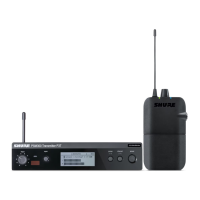
Do you have a question about the Shure PSM300 and is the answer not in the manual?
| Frequency range | 38 - 15000 Hz |
|---|---|
| Receiving frequencies | 488 - 937.5 MHz |
| Modulation | FM |
| Transmission distance | 90 m |
| Signal-to-Noise Ratio (SNR) | 90 dB |
| Product color | Black, Grey |
| Wireless technology | Radiofrequency (RF) |
| Operating time | 7 h |
| Receiver included | Yes |
| Receiver weight | 98 g |
|---|---|
| Transmitter weight | 783 g |
| Receiver dimensions (WxDxH) | 64 x 21 x 110 mm |
| Transmitter dimensions (WxDxH) | 198 x 172 x 43 mm |
Essential safety guidelines to prevent injury and product damage during operation.
Advises on safe listening levels to prevent permanent hearing damage.
Describes sending instrument and microphone signals to a mixer or PA system.
Explains how to create separate mixes for performers from the mixer.
Details the controls and connectors on the front and rear of the P3T transmitter.
Explains the indicators and information shown on the P3T transmitter's LCD screen.
Describes the meaning of various icons and indicators on the transmitter display.
Details the buttons, display, knobs, and outputs of the P3R receiver.
Explains the battery status indicators and expected runtime for the receiver.
Describes a basic setup for a solo performer or a group with one wireless monitor.
Explains how one transmitter can serve multiple performers.
Details how to use multiple transmitters for different monitor mixes for a group.
Explains how to route audio signals to external devices like stage monitors.
Describes how to install the P3T transmitter in a standard 19-inch rack.
Details the necessary connections for power, audio input, and antenna.
Step-by-step guide for syncing a receiver to a transmitter.
Process for syncing multiple receivers to a single transmitter.
Explains how to set input sensitivity and signal levels on the transmitter.
Details how to create custom monitor mixes for performers.
Explains the two audio modes available for receivers.
How to choose between Stereo and MixMode on the receiver.
Describes how MixMode allows blend adjustment between two audio mixes.
Guides on adjusting levels for instrumental and vocal mixes in MixMode.
Solutions for audio distortion issues, checking levels and connections.
Steps to diagnose and fix situations where no audio is heard from the receiver.
Addresses issues where the MixMode knob has no audible effect.
Solutions for low volume levels from the receiver.
Troubleshooting steps for intermittent audio or RF signal loss.
Common causes and solutions for failed IR synchronization.
Details technical specifications for the P3T transmitter unit.
Details audio input/output connector types, configuration, and impedance.
Technical specifications related to the receiver's RF performance.
Specifications for the receiver's physical size and battery runtime.
Lists available frequency bands and their corresponding transmitter output power levels.
Lists compliance with WEEE and RoHS directives.
States compliance with FCC and Industry Canada regulations.
FCC compliance information and user guidance for device operation.
Frequency band H8E details for various European countries.
Frequency band H2O details for various European countries.
Frequency band K3E details for various European countries.
Frequency band K12 details for various European countries.
Frequency band M16 details for various European countries.
Frequency band R12 details for various European countries.
Frequency band S8 details for various European countries.
Frequency band T11 details for various European countries.
Frequency band Q25 details for various European countries.